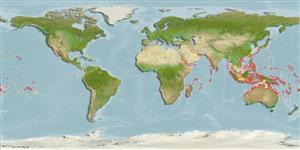>
Blenniiformes (Blennies) >
Blenniidae (Combtooth blennies) > Salariinae
Etymology: Cirripectes: Latin, cirrus = curl fringe + Greek, pektos, -e, -on = made of several parts solidly united (Ref. 45335); castaneus: Specific epithet 'castaneus' meaning brown or the color of chestnuts, presumably referring to the color of the holotype in alcohol..
More on author: Valenciennes.
Environment: milieu / climate zone / depth range / distribution range
Οικολογία
Θαλασσινό(ά); Υφάλμυρο Υφαλόφιλο(α); εύρος βάθους 0 - 32 m (Ref. 529), usually 0 - 10 m (Ref. 529). Tropical; 35°N - 35°S
Indo-West Pacific: Red Sea to Tonga, north to southern Japan; south to Lord Howe Island; Palau, Ifaluk, and Kapingamarangi in Micronesia.
Length at first maturity / Μέγεθος / Βάρος / Age
Maturity: Lm ?, range 4 - ? cm
Max length : 9.2 cm SL αρσενικό/απροσδιόριστο; (Ref. 529)
Ραχιαίες άκανθες (συνολικά): 11 - 13; Μαλακές ραχιαίες ακτίνες (συνολικά): 13-15; Εδρικές άκανθες 2; Μαλακές εδρικές ακτίνες: 14 - 16; Σπόνδυλοι: 29 - 31. Diagnosis: Dorsal fin XII, 14, membrane attached to caudal fin, with deep notch above last spine, first spine almost same or slightly higher than second; anal fin II, 15; pectoral rays 15; pelvic fin I, 4; caudal fin procurrent rays 10-14. Vertebrae 11 + 20. Body depth at anal-fin origin 3.2-3.5 in SL. Body depth at anal-fin origin 3.2-3.7 in SL. LL, without scales and scalelike flaps; LL tubes 1-13 (usually 3-12), canal ends below 5th dorsal ray to caudal-fin base. Lower lip smooth mesially, plicate laterally. Upper lip crenulae 29-50. Gill rakers 20-32. Cephalic sensory pore system simple; 1 pore behind each nuchal flap. Cirri, nuchal 29-44, nasal 6-49, supraorbital 6-49; nuchal cirri in 4 groups, ventralmost group on each side borne on slightly expanded nuchal flap. Meristic and morphological characters consistent; color pattern geographically variable. Males: Chagos, body bars alternating light and dark brown, dorsal spine tips and anterior caudal fin rays yellow; Red Sea, head and anterior body bars narrow red on brown background; GBR, head and body bars alternating pink and brown; Fiji, body bars brown on grey or yellow background; Comoros, bars reddish brown, slightly oblique. Females: mostly with reticulated pattern of wavy brown lines and pale polygonal spots; others plain brown, particularly those from South Africa and Kenya Head with spots and lines; iris with irregular red ring around outer part of eye, narrow yellow ring around pupil, with black between the ring (Ref. 529, 90102).
Facultative air-breathing (Ref. 126274); Adults occur in wave-swept algal ridge (Porolithon ridge) of outer reef flats. Usually found on rocky and coralline substrates at depths less than 10 m. Usually seen in small loose groups spread over sections of reef (Ref. 48636). Oviparous. Eggs are demersal and adhesive (Ref. 205), and are attached to the substrate via a filamentous, adhesive pad or pedestal (Ref. 94114). Larvae are planktonic, often found in shallow, coastal waters (Ref. 94114). Have been collected as deep as 30 m in the Red Sea, 32 m at Rowley Shoals off Western Australia (Ref. 529).
Oviparous, distinct pairing (Ref. 205). Urogenital orifice of male genital papilla located basally between 2 widely separated slender filaments on a fleshy swelling behind anus; testes bulbous with length equal to its width (Ref. 529).
Williams, J.T., 1988. Revision and phylogenetic relationships of the blenniid fish genus Cirripectes. Indo-Pac. Fish. (17):78 p. (Ref. 529)
IUCN Red List Status (Ref. 130435)
Threat to humans
Harmless
Human uses
Ενυδρείο: Εμπορικό(ά)
Περισσότερες πληροφορίες
ΑναφορέςΥδατοκαλλιέργειεςΠροφίλ υδατοκαλλιέργειαςΣτελέχοιΓενετικήElectrophoresesΚληρονομικότηταΑσθένειεςΜεταποίησηNutrientsMass conversion
ΣυνεργάτεςΦωτογραφίεςStamps, Coins Misc.ΉχοιΣιγκουατέραΤαχύτηταΚολυμβητικός ΤύποςΕπιφάνεια βραγχίωνOtolithsΕγκέφαλοιΌραση
Εργαλεία
Special reports
Download XML
Διαδικτυακές πηγές
Estimates based on models
Preferred temperature (Ref.
123201): 24.3 - 29.3, mean 28.2 °C (based on 3175 cells).
Phylogenetic diversity index (Ref.
82804): PD
50 = 0.5000 [Uniqueness, from 0.5 = low to 2.0 = high].
Bayesian length-weight: a=0.00741 (0.00335 - 0.01640), b=3.02 (2.83 - 3.21), in cm total length, based on LWR estimates for this (Sub)family-body shape (Ref.
93245).
Τροφικό Επίπεδο (Ref.
69278): 2.0 ±0.00 se; based on food items.
Ελαστικότητα (Ref.
120179): Υψηλό, ελάχιστος χρόνος για διπλασιασμό πληθυσμού < 15 μήνες (Preliminary K or Fecundity.).
Fishing Vulnerability (Ref.
59153): Low vulnerability (10 of 100).
Nutrients (Ref.
124155): Calcium = 153 [69, 272] mg/100g; Iron = 0.805 [0.447, 1.480] mg/100g; Protein = 18 [17, 19] %; Omega3 = 0.0977 [, ] g/100g; Selenium = 25.1 [10.8, 63.9] μg/100g; VitaminA = 115 [30, 446] μg/100g; Zinc = 3.04 [1.93, 4.68] mg/100g (wet weight);
